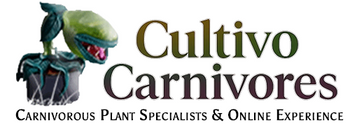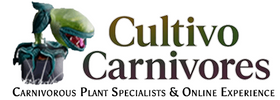THE HELP FILES: GROW LIKE A PRO
The complete beginners guide with basic care instructions. Learn how to grow carnivorous plants in our South African climate
VENUS FLYTRAPS (Dionaea Muscipula)
LIGHT:- Venus flytraps need a lot of light to thrive. Plants can be grown in a protected area outdoors with full sun, year round
- In Gauteng, we recommend growing flytraps outdoors with (at the very least) 6 hours direct (unfiltered) morning sun. Note that during summertime soil may become very hot and plants may overheat during heatwaves. During these spells, protect your plant from the harsh afternoon sun
WATER:
- As venus flytraps are bog plants, always keep the soil moist using the tray method. Top-watering is fine during winter time when plants are dormant and sluggish traps will not be triggered accidentally
- The tray method: Place your plant in a shallow tray and fill with a half to 1cm water - the soil is designed to absorb water from the bottom. Fluctuate the water level to air the roots by letting the tray dry slightly between waterings, but never let the plant itself dry out completely. If this procedure is followed during the growing season, you can use the same watering schedule during the colder months when the plant is dormant
- Low-mineral water is highly recommended and we use distilled- or reverse osmosis water, (OASIS WATER) when rainwater is scarce. Store bought bottled water such as Valpre, H20 etc often contains additional minerals (to make it taste better for humans😊) but is not suitable for carnivorous plants
- Protect your plant from hailstorms and very strong winds. Rainwater is not only the cheapest carni-thirst-quencher but also the best for them so leave them outside on rainy days, they'll thank you for it
FEEDING:
- Carnivorous plants are self-sufficient hunters and have adapted to catch and digest their own food. As venus flytraps are plants, their growing energy is derived from the sun via photosynthesis (Therefor your plant will never die due to starvation). Grow your plant outdoors - During the growing season they will lure, catch and digest their own insects which acts as a type of fertiliser. Never feed your flytrap hamburger meat, viennas, biltong, braaivleis, milk or vegetables (Let me know if I left something out 😂 )
- Venus flytraps also do not eat human fingers or pencils. Trap movement (as well as digestion) requires a lot of energy and therefor each trap have a limited lifespan for opening and closing - usually 1-3 times. Triggering the traps manually may look like fun, but only waste their energy and the trap will soon die off
- It is normal for older traps to die due to aging. The traps will start blackening from the teeth, then the trap itself and then the stem it is attached to. Wait for the whole trap and it's attached stem to become dry (almost crispy) and snip it off close to the base of the plant for a cleaner plant. As long as your plant gets enough direct sunlight, it will continue producing new traps from the growthpoint in the middle of the plant during the growing season (October - April)
SOIL:
- Do not fertilise your plant and only use sphagnum-peat based plant soil, which is low in nutrients and minerals. Compost, coco peat, palm peat and regular garden variety potting soil contains salts and minerals that will kill your plant
- We recommend repotting venus flytraps yearly, into fresh carnivorous plant soil, at the end of winter dormancy, around August
WINTER DORMANCY:
- Venus flytraps are sun-loving temperate plants which means they grow actively during summertime, and die back to a dormant rhizome (underground stem) during the winter months when the daylight period is shorter
- If you are new to carnivorous plants, see our FAQ section on what to expect from your plant during dormancy
- During dormancy, keep the soil only moist to the touch while still providing as much direct sunlight as possible. Venus flytraps can easily handle light freezes and can be overwintered in an unheated greenhouse or protected area with as much direct sunlight as possible
- Please note that images mostly represent mature plants in full summer growth cultivated in optimal conditions
- Plants will appear smaller, and traps close slower during and a couple of weeks after the dormancy period in the colder months of the year (Usually May to October)
QUICK REFERENCE GUIDE:
- This is a lot to digest, but following this guide we trust that your venus fly trap will thrive in your care. Below is a quick reference guide on growing a happy and healthy venus flytrap


